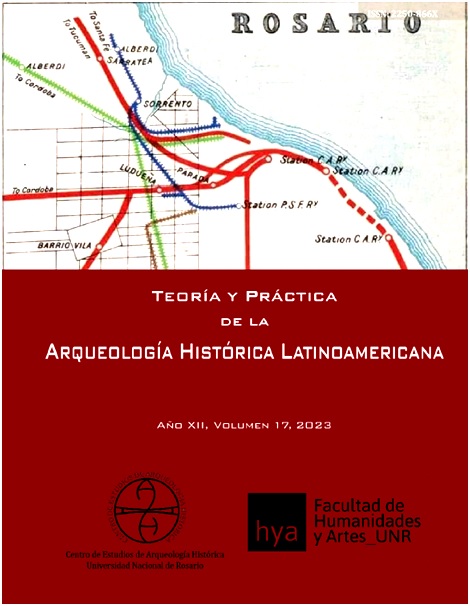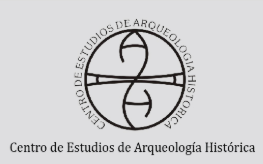Barato e escasso: faiança decorada com esponja em Rosário, Argentina (1870-1900)
DOI:
https://doi.org/10.35305/tpahl.v17i1.205Palavras-chave:
Arqueologia urbana, louças, RosarioResumo
A decoração da cerâmica industrial doméstica durante o século XIX era muito variada e respondia a um sistema de produção, distribuição e consumo. Rosário, como cidade emergente, com a introdução do capitalismo em 1870 na Argentina, não poderia permanecer alheia a esse sistema e o registro arqueológico pode refletir indiretamente esse contexto geral, mas articulado ao local. Um conjunto de faianças – aquelas decoradas com esponja ou esponjosa – apesar da sua aparente insignificância quantitativa mostra como os produtos industriais europeus chegaram a uma cidade que, naquela época, estava em processo de mudança económica e social. As transformações globais e locais do mercado podem ser lidas neste pequeno complexo arqueológico, que pertence às três últimas décadas do século XIX. O objetivo deste trabalho é mostrar esses processos socioeconômicos por meio desses fragmentos recuperados dos lixões de Rosário.
Downloads
Referências
Andrade Lima, T. (1995). Pratos e mais pratos: loucas domésticas, divisioes culturais e limites osciais no Río do Janeiro, século XIX. Anais do Museo Paulista 3, 129-191.
Boa, V. N. S. (2012). Clyde Pottery Wares in the McLean Museum Collection.Recuperado de: https://www.inverclyde.gov.uk/assets/attach/7460/Clyde-Pottery-Wares-in-the-McLean-Museum.pdf. Últimoacceso: 11 dediciembre de 2021.
Boness´Pottery. The Industry of e pottery of Borrowstounness. (2009): Mary Finlay. Recuperado de: http://bonesspottery.co.uk/fim.html. Último acceso: 14 de marzo de 2022.
Brooks, A.; Urbina, S.; Adán, L.; Carabias, D. Sepíulveda, V. Chiavazza, H. y Zorrilla, V. (2019). The Nineteenth-Century British Ceramics Trade to Southwestern South America: An Initial Characterization of the Archaeological Evidence from Chile. En: C. E. Orser Jr. (ed.). Archaeologies of the British in Latin America Contributions To Global Historical Archaeology. Springer International Publishing. 55-71.
Campbell, H. (1982). Spongeware.Historical Review 1982-1983. Coburg, Ontario, Canada: Cobourg and District Historical Society. 37-39.
Campbell-Green, T. (2011). The Rough Guide to Pottery Pt.2 – Spongeware. The Glossop Cabinet of Curiosities. Recuperado de: https://glossopcuriosities.wordpress.com/2022/02/11/the-rough-guide-to-pottery-pt-2-spongeware/. Ultimo acceso: 3 de noviembre de 2021.
Cruickshank, G. (1985). Scottish pottery. Princes Risborough, ReinoUnido: Shire Books.
Diagnostic Artifacts in Maryland. (2012). Sponged decorated wares. Maryland, EEUU: JPPMRecuperado de: https://apps.jefpat.maryland.gov/diagnostic/Post-Colonial%20Ceramics/SpongedWares/index-spongedwares.html. Último acceso: 22 de febrero de 2022.
Dietz, U. G. (1980). A New Look at the Spatterware at Winterthur. Winterthur, Delaware, EEUU: Winterthur Museum.
Dócola, S. (2017). De una aldea sin límites al proyecto de delineación paradefinir una ciudad capital: Rosario 1852-1873. Analesdel IAA. 47 (2), 161-173.
Earls, Amy (2004). A Selection of Cut Sponge Designs, Part 1. Victorian Ceramics Group Newsletter 5 (1). 21-23.
Fernetti, G. (2020). Las lozas decoradas del sitio “La Basurita” como indicadoras de cambio socioeconómico. Rosario, Argentina (1873-1920). Urbania. Revista Latinoamericana de Arqueología e Historia de las Ciudades, 9. 63-92.
Fernetti, G.(2022a). Los platos “Patrón Trigo” (WheatPattern) en Rosario, Argentina (1880-1960) en la evolución socioeconómica de la ciudad. Revista De Arqueología Histórica Argentina Y Latinoamericana 15(1), 8–31.
Fernetti, G. (2022b). Muchas flores, pocos colores. La técnica de decoración por trasferencia en lozas arqueológicas de Rosario, Argentina (1870-1920). Teoría y Práctica De La Arqueología Histórica Latinoamericana 16(1). 93–118.
Fleming, J. (1923). Scottish Pottery. Glascow: Maclehose, Jackson & Co.
Hamer, F. y Hamer, J. A (2004). The Potter's Dictionary of Materials and Techniques. Londres: A & C Black.
Henríquez Ursúa, M., Reyes Álvarez, V., Popovic Silva, V. y Alamos Cardemil, I. (2013). Cerámicas y vidrios. Colección Museo Regional de Rancagua. Andros Impresores.
Hidalgo Gutiérrez, J. (2020) Lozas para el Nuevo Mundo. La presencia de loza fina en el puerto de Campeche (1850-1900). Tesis de grado. Programa de maestría y doctorado en Estudios Mesoamericanos. Facultad de Filosofía y Letras. Instituto de Investigaciones Filológicas. México: Universidad Nacional Autónoma de México.
Hunter, R. (2006). Surfaces of Illusion: Mocha and Spatterwares. En Jane Katcher, David A. Schorsch and Ruth Wolfe (eds.) Expressions of Innocence and Eloquence; Selections from the Jane Katcher Collection of Americana. . 207-229.New haven: Yale University Press
Jarret., C.; Cross, M. y Robertson, A. (2016). Archaeological evidence for the exported wares of the caledonian pottery, Rutherglen, and its role in Glasgow´s ceramic international trade and industry. En: Brooks, A. The Importance of British Material Culture to Historical Archaeologies of the Nineteenth Century. Nebraska, EE.UU.: University of Nebraska Press.
Kelly, H. (1993). Scottish Sponge-printed Pottery: Traditional Patterns, Their Manufacturers and History.Glascow: The Lomondside Press.
Kelly, H. (1994). The Beginning of the Pottery Industry in Greenock. Scottish Industrial History 17. 57-75.
Kelly, H. (2007). Scottish Ceramics. Atglen, EEUU: Schiffer Publishing Ltd
Kelly, H; Kowalsky, A. y Kowalsky, D. (1993). Spongeware: 1835-1935, Makers, Marks, and Patterns. Atglen, EEUU: Schiffer Publishing Ltd
Ketchum, W. (1983). American country pottery. Yellowware and spongeware.Random House USA Inc.
Klose, J. y Malan, A. (2014). An introduction to the identification of ceramics excavated from 18th and 19th century archaeological sites. El Cabo, Sudáfrica: Historical ArchaeologyResearch Group, Universidad de Ciudad del Cabo (UCT).
Langeweg, S. (2004) De techniek van hetversieren: hetdecoreren van aardewerkbijRegout/Sphinx en Société Céramique in Maastricht. Studiesover de sociaal-economischegeschiedenis van Limburg/Jaarboek van hetSociaalHistorischCentrumvoorLimburg XLIX. 97-133.
Lawrence, S. (2003). Exporting culture. Archaeology and the nineteenth century British Empire. En: Historical Archaeology 37(1). 20-33
Liebeknecht, W. B. (2001). Joseph Mayer’s Arsenal Pottery Dump Part 3: Cut Sponge Decorated Ironstone China. Trenton Potteries; Newsletter of the Potteries of Trenton Society 2 (3-4). 1-4.
McCollen, H. (2001). Spongeware and Spatterware. Atglen, EEUU: Schiffer Publishing Ltd.
Majewski, T. y O’Brien, M. (1987). The Use and Misuse of Nineteenth-Century English and American Ceramics in Archaeological Analysis. En Michael B. Schiffer (ed.) Advances in Archaeological Method and Theory 11. Nueva York: Serial Publication Series. Academic Press. 97-207.
Miller, G. (1980). Classification and Economic Scaling of 19th Century Ceramics. Historical Archaeology. 14. 1-40.
Miller, G. y Earls, A. (2008). War and Pots: The Impact of Economics and Politics on Ceramic Consumption Patterns. En R. Hunter (Ed). Ceramics in America.https://www.chipstone.org/article.php/413/Ceramics-in-America-2008/War-and-Pots:-The-Impact-of-Economics-and-Politics-on-Ceramic-Consumption-Patterns. Últimoacceso: 22 de febrero de 2022.
Otte, J. (2019). The trade in European earthenware with the Dutch East Indies 1820-1940. En: VormenuitVuur 241. 2-19.
Prieto, A. (2017). Rosario: la pregunta por la belleza. En Entresiglos: el impulso cosmopolita en Rosario. 1a ed. Ilustrada. Rosario, Argentina: Ediciones Castagnino/Macro. Museo Municipal de Bellas Artes J. B. Castagnino. 17-34.
Robacker, E. F. y Robacker A. F. (1978). Spatterware and Sponge; Hardy Perennials of Ceramics. A. S. Cranbury. New Jersey, EEUU: Barnes and Company, Ed.
Sandling, T. (2018). London in Fragments: A Mudlark's Treasures. Londres: Frances Lincoln Ed.
Sandy, J. y Stevens, N. (2021). Thames Mudlarking: Searching for London's Lost Treasures.Londres: Bloomsbury Publishing.
Schávelzon, D. (2001). Catálogo de lozas históricas de Buenos Aires (siglos XVI - XX). Con notas sobre la región del Río de la Plata. Facultad de Arquitectura, Diseño y Urbanismo. Buenos Aires: UBA
Schvarzer, J. (1996)- La industria que supimos conseguir. Una historia político-social de la industria argentina. Planeta. ColecciónHistoria Argentina.
Stelle, L. J. (2001). An archaeological guide to historic artifacts of the upper Sangamon Basin, Central Illinois, USA. Illinois: Center For Social Research, Parkland College. Recuperado de:
https://virtual.parkland.edu/lstelle1/len/center_for_social_research/english_registry_marks/ARCH%20GUIDE_ENGLISH%20REGISTRY%20MARKS.html. Último acceso: 11 de marzo de 2022
Sussman, L. (1985). TheWheatpattern. An Illustrated Survey. Studies in Archaeology Architecture and History. Ottawa: National Historic Parks and Sites Branch Parks Canada Environment.
Volpe, S. y Fernetti, G. (2018). El Baño de Mandinga (Rosario, Santa Fe, Argentina, 1910): Arqueología de una tierra de nadie. Revista De la Escuela de Antropología XXIV. 1–18.
Volpe, S. y Fernetti, G. (2019). Prospección de basurales históricos de la ciudad de Rosario. Teoría y Práctica De La Arqueología Histórica Latinoamericana 9(1). 19–35.

Downloads
Publicado
Como Citar
Edição
Seção
Licença
Copyright (c) 2023 Teoría y Práctica de la Arqueología Histórica Latinoamericana

Este trabalho está licenciado sob uma licença Creative Commons Attribution-NonCommercial-ShareAlike 4.0 International License.






